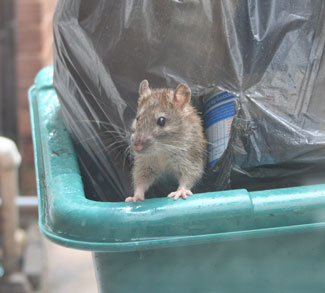Where Do Rats Nest?
By Chris Williams on December 29, 2014.
 Our common rat, the brown rat (also called the Norway rat) usually nests in burrows dug into the ground. The burrows are shallow (less than 18 inches deep) and usually short (less than 3 feet long), with a central nest area. The nest itself is lined with any kind of soft material, including leaves, grasses, and garbage. Burrow openings are about 2 to 4 inches in diameter (see Could Those Be Rat Holes?).
Our common rat, the brown rat (also called the Norway rat) usually nests in burrows dug into the ground. The burrows are shallow (less than 18 inches deep) and usually short (less than 3 feet long), with a central nest area. The nest itself is lined with any kind of soft material, including leaves, grasses, and garbage. Burrow openings are about 2 to 4 inches in diameter (see Could Those Be Rat Holes?).
The area around the opening is usually smooth, hard-packed dirt that is kept free of leaves and debris. You may see dark, greasy rubmarks around the burrow opening from oils in the rat’s hairs. Newly-opened burrows may have loose soil pushed out of the entrance in a fan-shaped pattern. Besides the main entrance hole, the burrow will often have extra “bolt holes” for quick escapes.
Where Are Rat Burrows Located?
Outside of cities and human development, feral brown rats are associated with crop fields and water, often burrowing in fields or along streams or creeks. But rats are well adapted to urban environments and the lure of people food. Here, they will dig burrows in heavy grass, thick shrubbery or groundcover, or under boards, woodpiles, stonewalls, or other heavy objects.
Rats also like to locate their burrows under sheds, foundations, concrete slabs, or sidewalks. You will likely see a roughly half-moon shaped opening at the edge of the cement. The burrow and nest is actually under the slab. In heavy rat populations, you might see many burrow openings grouped together in a desirable location. Rats will nest as close to a reliable food source as possible. Concrete dumpster pads are a favorite nest site for rats since they have protection and food nearby.
What’s the Size of a Rat’s Territory?
Rats may have more than one nest site. A rat may spend a week in its home base and then move for a day or two into a secondary “hotel” nest site. Brown rats have been shown on occasion to have a home range of up to 20 acres when these secondary nest sites were included in the calculations. But on a typical night, a typical brown rat might range only 25 to 100 feet from its nest, especially if food is available nearby (see How Far Will Rats Roam?).
Rats Will Nest Inside, Too!
Rats aren’t limited to ground burrows for nest sites. Brown rats will also nest indoors and in sewers. Inside, they will build nests in wall voids, in the space between floors and ceilings, underneath equipment, between and under storage pallets, and in crawl spaces, storage rooms, and any cluttered area that is rarely occupied. Rats will build nests inside stuffed furniture and mattresses. Like outdoor burrows, indoor nests will be lined with all kinds of found soft materials such as cloth, string, paper, and plastic.
Brown rats are the most common rats nesting in sewer systems. Unfortunately, they don’t stay in the sewers. They find breaks in pipes and can burrow up into yards or even follow lateral lines into buildings (see Rats in Sewers!).
If you think you may have rats nesting on your property, give Colonial a call. Rats don’t hibernate so you can expect them to be actively foraging throughout the winter…unless you have a professional exterminator on the job!
Stay up-to-date with Colonial Pest’s email newsletter!